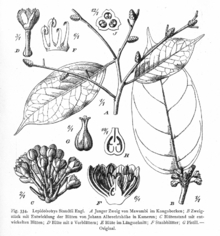| Lepidobotrys | |
|---|---|

| |
| Lepidobotrys staudtii, from Vegetation der Erde (1915) | |
| Conservation status | |
 Least Concern (IUCN 3.1) | |
| Scientific classification | |
| Kingdom: | Plantae |
| Clade: | Tracheophytes |
| Clade: | Angiosperms |
| Clade: | Eudicots |
| Clade: | Rosids |
| Order: | Celastrales |
| Family: | Lepidobotryaceae |
| Genus: | Lepidobotrys Engl. |
| Species: | L. staudtii |
| Binomial name | |
| Lepidobotrys staudtii Engl. | |
Lepidobotrys is a flowering plant genus in the family Lepidobotryaceae. It contains only one species, Lepidobotrys staudtii. L. staudtii is a small African tree, ranging from Cameroon eastward to Ethiopia.
The tannin 3,4,5-tri-O-galloylquinic acid is found in L. staudtii.
Taxonomic history
Lepidobotrys staudtii was named and described by Adolf Engler in 1902 and placed by him in the family Linaceae. It was regarded as somewhat of an anomaly and during the 20th century, was assigned to various families by different authors. Hans G. Hallier and Reinhard Knuth put it in Oxalidaceae. In 1950, Jean Leonard became the first to put it in a family by itself, which he thought to be close to Linaceae. Arthur Cronquist, agreeing with Hallier and Knuth, put it in Oxalidaceae. Adding to the confusion was the lack of any strong basis for placing these and related families into orders.
Etymology
Lepidobotrys is derived from Greek, meaning 'scale-cluster'. The name is in reference to the cone-like arrangement of its bracts, which extend under the flowers.
References
- Botanic Gardens Conservation International (BGCI) & IUCN SSC Global Tree Specialist Group (2019). "Lepidobotrys staudtii". IUCN Red List of Threatened Species. 2019: e.T143655691A143719523. doi:10.2305/IUCN.UK.2019-1.RLTS.T143655691A143719523.en. Retrieved 22 May 2023.
- Klaus Kubitzky. "Lepidobotryaceae" In: Klaus Kubitzki (ed.). The Families and Genera of Vascular Plants vol.VI. Springer-Verlag: Berlin,Heidelberg, Germany (2004).
- Vernon H. Heywood, Richard K. Brummitt, Ole Seberg, and Alastair Culham. Flowering Plant Families of the World. Firefly Books: Ontario, Canada. (2007).
- 3,4,5-tri-O-galloylquinic acid on home.ncifcrf.gov
- Adolf Engler (May 1902). section: Linaceae africanae In: "Beitrage zur Flora von Afrika" In: Botanische Jahrbücher für Systematik, Pflanzengeschichte und Pflanzengeographie 32(1):108 (see External links below)
- Hans G. Hallier. Lepidobotrys Engl.: "Die Oxalidaceen und die Geraniaceen" Beihefte zum Botanischen Centralblatt 39(2):163.
- Reinhard G.P. Knuth. "Oxalidaceae" In: Adolf Engler and Karl Prantl. Die Naturlichen Pflanzenfamilien ed.2 volume 19a:40-41.
- Jean J.G. Leonard (Jun1950). "Lepidobotrys Engl., type d'une famille nouvelle de Spermatophytes: les Lepidobotryaceae" Bulletin du Jardin botanique de l'Etat a Bruxelles 20(1):38.
- Arthur Cronquist. An Integrated System of Classification of Flowering Plants. Columbia University Press: New York 1981.
- Gledhill, David (2008). "The Names of Plants". Cambridge University Press. ISBN 9780521866453 (hardback), ISBN 9780521685535 (paperback). pp 234
External links
| Taxon identifiers | |
|---|---|
| Lepidobotrys | |
This rosid article is a stub. You can help Misplaced Pages by expanding it. |